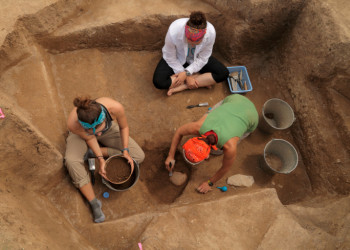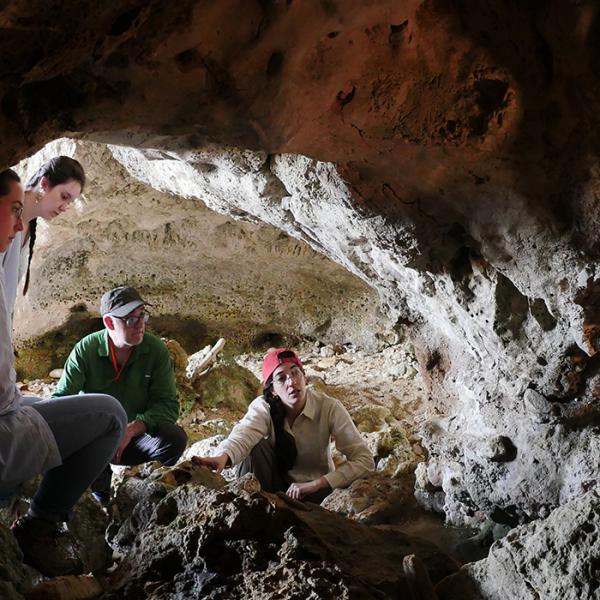 My dissertation work examines how movement of populations and individuals shaped religious and biological communities in medieval Central Asia. I compare regional biological variation to burial practice and historically documented political regimes to trace how local practice and interaction contributed to large scale social processes. During the medieval period, Central Asia experienced dramatic social change that took it from a region of diverse religious practice, dominated by Iranian culture and language, to a place where Islam and Turkic language and culture dominated. These social landscapes still shape Central Asia today, but the nature of this period of change is poorly understood. Historical narratives describe the process as dictated by the actions of ruling dynasties patronizing Islamic and Turkic culture in large urban centers, their influence only slowly trickling out to rural regions. My work seeks to examine how the practices of groups and individuals shaped these broad changes while also creating meaningful social communities on a local scale.
My dissertation work examines how movement of populations and individuals shaped religious and biological communities in medieval Central Asia. I compare regional biological variation to burial practice and historically documented political regimes to trace how local practice and interaction contributed to large scale social processes. During the medieval period, Central Asia experienced dramatic social change that took it from a region of diverse religious practice, dominated by Iranian culture and language, to a place where Islam and Turkic language and culture dominated. These social landscapes still shape Central Asia today, but the nature of this period of change is poorly understood. Historical narratives describe the process as dictated by the actions of ruling dynasties patronizing Islamic and Turkic culture in large urban centers, their influence only slowly trickling out to rural regions. My work seeks to examine how the practices of groups and individuals shaped these broad changes while also creating meaningful social communities on a local scale.
I use multiple lines of evidence to address my research questions, with an emphasis of mortuary analysis and bioarchaeological methods. In my dissertation, I recorded elements of burial practice to track the presence of religious communities in various site contexts, particularly those with evidence of Islamic practice. The composition of biological communities was evaluated through geometric morphometric analysis of crania. My data collection occurred between 2013 and 2017, during which I conducted field excavations in southeastern Uzbekistan and laboratory analysis on osteological and archival collections in the Institute of Archaeology in Samarkand, Uzbekistan. I led excavations of the cemetery at the site of Tashbulak during the summers 2015 and 2017. Tashbulak is a 10th-12th c. CE site in the Malguzar Mountains of southeastern Uzbekistan. Despite its location in a nomadic region, the site includes extensive architecture and a large cemetery of over 400 burials.
Human movement has been a formative process throughout our past. While humans exhibit a panoply of strategies related to mobility, some element of movement has been constant throughout our existence. The effects of movement can have far reaching, even global, impacts which can make migration appear an unstoppable monolith, whose biology is necessarily tied to its cultural identity. This is especially true in the archaeological record, where the nature of our data necessitates assumptions and interpolation. My research reveals points of convergence and departure between biological and cultural identity. By breaking down this assumed correlation, my work creates room for multivocality in the bioarchaeological record.
 My dissertation work examines how movement of populations and individuals shaped religious and biological communities in medieval Central Asia. I compare regional biological variation to burial practice and historically documented political regimes to trace how local practice and interaction contributed to large scale social processes. During the medieval period, Central Asia experienced dramatic social change that took it from a region of diverse religious practice, dominated by Iranian culture and language, to a place where Islam and Turkic language and culture dominated. These social landscapes still shape Central Asia today, but the nature of this period of change is poorly understood. Historical narratives describe the process as dictated by the actions of ruling dynasties patronizing Islamic and Turkic culture in large urban centers, their influence only slowly trickling out to rural regions. My work seeks to examine how the practices of groups and individuals shaped these broad changes while also creating meaningful social communities on a local scale.
My dissertation work examines how movement of populations and individuals shaped religious and biological communities in medieval Central Asia. I compare regional biological variation to burial practice and historically documented political regimes to trace how local practice and interaction contributed to large scale social processes. During the medieval period, Central Asia experienced dramatic social change that took it from a region of diverse religious practice, dominated by Iranian culture and language, to a place where Islam and Turkic language and culture dominated. These social landscapes still shape Central Asia today, but the nature of this period of change is poorly understood. Historical narratives describe the process as dictated by the actions of ruling dynasties patronizing Islamic and Turkic culture in large urban centers, their influence only slowly trickling out to rural regions. My work seeks to examine how the practices of groups and individuals shaped these broad changes while also creating meaningful social communities on a local scale.

